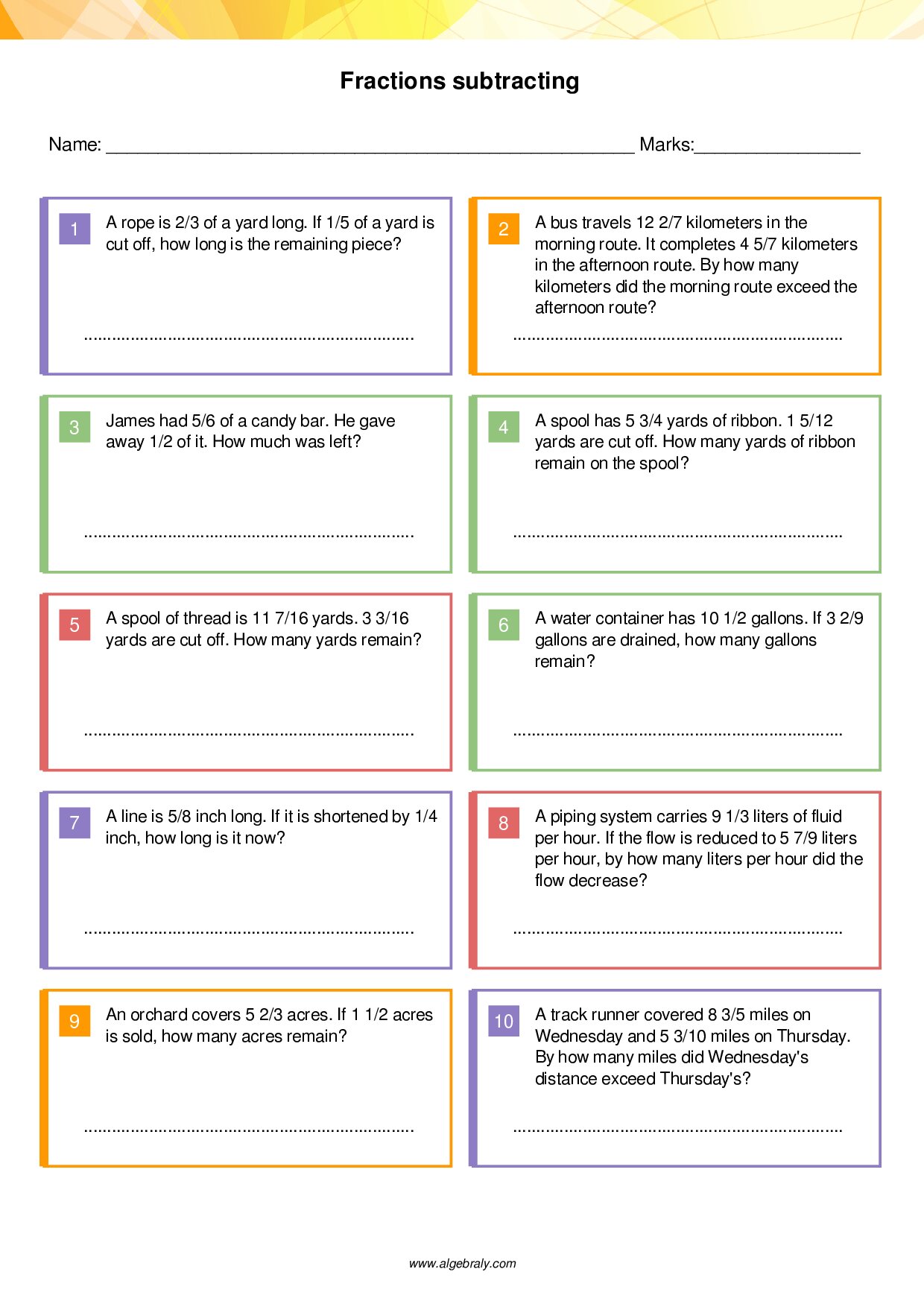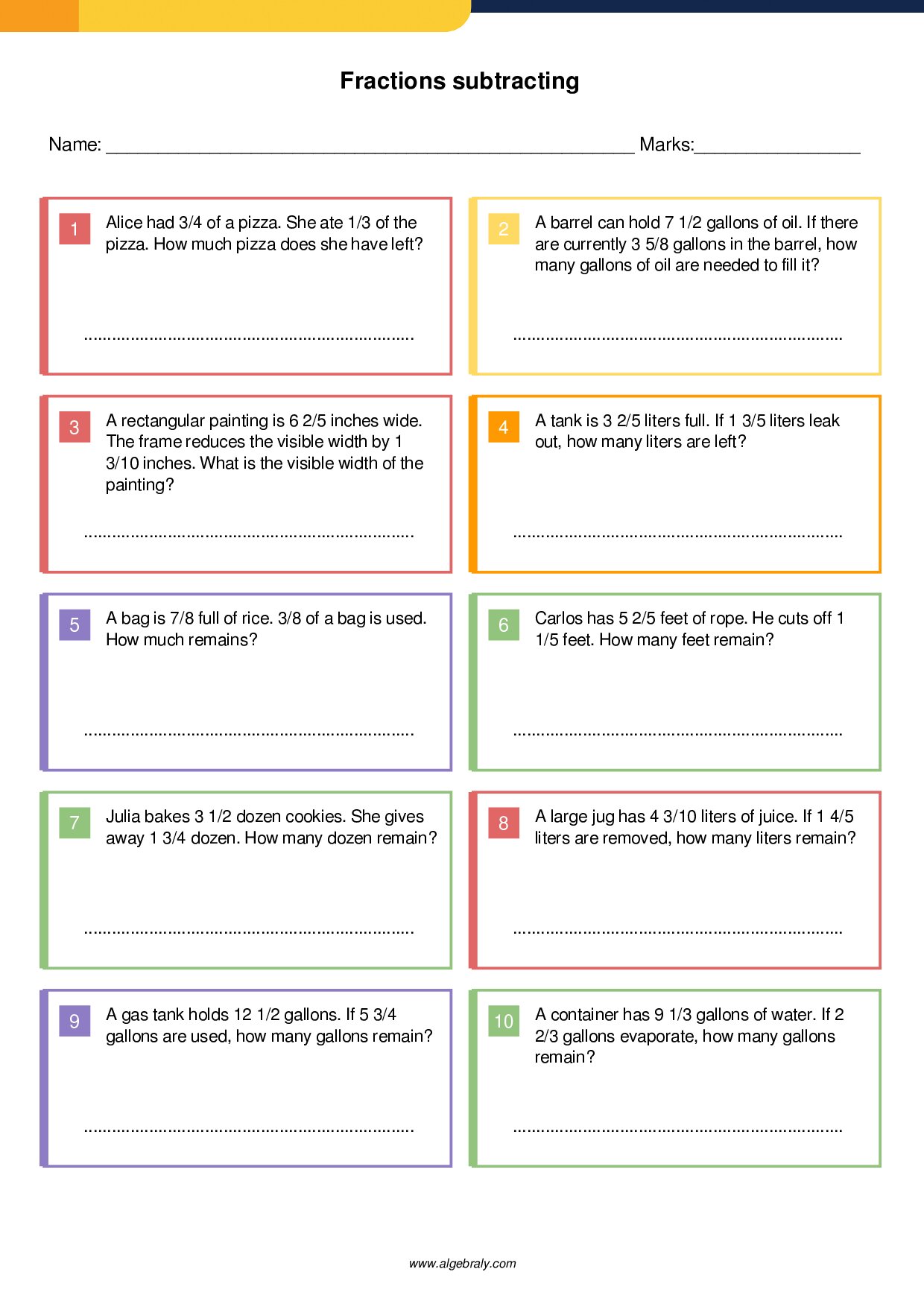Dynamically Generated Subtracting Fractions Worksheet
Subtracting Fractions Quiz – Word Problems
Anne had 3/4 lb of sugar. She used 1/6 lb. How much sugar is left?
These Subtracting Fractions Worksheet resources provide a hands-on and engaging way for teachers or parents to help students tackle the sometimes tricky process of subtracting fractions. By using real-world scenarios, such as cooking measurements or distance covered during a run, learners see the relevance of subtracting fractions, subtracting fractions with whole numbers, and understanding part-whole relationships in everyday life.
Each dynamic worksheet is designed to enhance problem-solving and reasoning skills, while also encouraging careful reading comprehension. Students encounter tasks that range from straightforward numerical subtractions to more challenging algebraic word problems often found in an Pre-Algebra curriculum.
The page offers a convenient form to generate unique Subtracting Fractions Worksheet sets, each containing 15 distinct word problems. These worksheets are downloadable in PDF format and making them easy to print or share electronically. An online quiz is also available for a more interactive approach. This quiz allows students to practice subtracting fractions independently, providing immediate feedback and reinforcing each concept. Emphasizing an intuitive and conversational style helps learners remain engaged without feeling overwhelmed.
In addition, the focus on real-world application shows students that subtracting fractions goes far beyond the classroom. From cooking in the kitchen to measuring supplies for art projects, learners recognize how these skills play out in daily tasks. This practical exposure not only fosters deeper understanding but also builds confidence in tackling future math challenges. Whether used as a supplement to classroom instruction or as a home study tool, these Subtracting Fractions Worksheet sets and online quiz offer a comprehensive, student-friendly approach that supports consistent growth in algebraic thinking.
Skills Focused: Subtracting fractions, Real-world application, Problem-solving and reasoning, Reading comprehension
How to Solve a Subtracting Fractions Problem
Sasha has 1 1/4 cups of flour. She needs 3/5 cup for a recipe. How much flour will she have left?
Time needed: 2 minutes
Learn how to subtract fractions by converting mixed numbers to improper fractions and finding a common denominator.
- Identify the Mixed Fraction
Sasha has 1 and 1/4 cups of flour, which is a mixed fraction.
- Convert to an Improper Fraction
Convert 1 1/4 cups to 5/4.
- Subtract 3/5 Cup
Set up the subtraction: 5/4 – 3/5.
- Find the Common Denominator
The denominators are 4 and 5, so the LCM is 20.
- Convert Fraction
Convert 5/4 to 25/20 and 3/5 to 12/20.
- Perform the Subtraction
25/20 – 12/20 = 13/20.
- Simplify if Needed
Check if 13/20 can be reduced further; it cannot, so 13/20 is the final answer.
Learn More about Subtracting Fractions - Frequently Asked Questions
How do you subtract fractions with different denominators?
You need a common denominator first. That usually means finding the least common multiple (LCM) of both denominators. Then, convert each fraction so they share this new denominator and subtract the numerators as usual.
Why do we need a common denominator to subtract fractions?
Having a common denominator allows you to compare the two fractions on the same “scale,” which makes the subtraction straightforward. If denominators are different, you’re essentially subtracting unequal parts, so you must adjust them to a common baseline first.
What are the steps to subtract mixed numbers?
Step 01 – Convert the mixed numbers to improper fractions so everything is simpler.
Step 02 – Find a common denominator if needed. Subtract the numerators and keep the same denominator.
Step 03 – Turn the result back into a mixed number if it’s improper.
How do you subtract fractions from whole numbers?
Treat the whole number as a fraction with a denominator of 1.
For example, 5 is 5/1. Then find a common denominator and subtract the fractions as usual. It might help to convert the whole number into a mixed or improper fraction if it makes the calculation clearer.
Can you subtract fractions without a calculator?
As long as you follow the steps, finding a common denominator, rewriting the fractions, subtracting the numerators, and simplifying the result, you can do it by hand. It just takes a bit of practice.
How do you simplify the answer after subtracting fractions?
You look for any common factor between the numerator and denominator. If there is one, you divide by that common factor to reduce the fraction to its simplest form.
What if my answer is an improper fraction?
If the numerator is larger than the denominator, you have an improper fraction. You can leave it as is, or convert it to a mixed number by dividing the numerator by the denominator. The quotient becomes the whole part, and the remainder goes over the original denominator.
How can I subtract fractions mentally?
Subtracting fractions mentally often works best if one denominator is a multiple of the other. In that case, it’s easier to do quick conversions. Otherwise, writing the fractions down ensures you don’t make a mistake.
What if my subtraction problem ends up with a negative fraction?
A negative fraction simply means the second fraction was larger than the first. You follow the same steps for finding a common denominator and subtracting. If the result is negative, just include the minus sign in front.
Is it possible to subtract fractions without converting to improper fractions?
Yes, If you’re comfortable working with mixed numbers directly. However, many find it simpler to handle improper fractions—there’s less potential for confusion when adding or subtracting whole parts and fractions separately.
How do I handle “borrowing” when subtracting fractions in mixed numbers?
You convert one whole unit from the mixed number into an equivalent fraction. For example, if you have 3 1/4 and need to subtract 3/4, you can borrow 1 from 3, which gives 2 + 5/4. Then subtract normally.
Do I always have to simplify or reduce my final fraction?
It’s good practice to simplify the final answer so it’s in lowest terms. In many math classes, fully simplified fractions are required to show you understand the complete process.
What’s the easiest way to check my fraction subtraction?
A quick way is to add the answer you got back to the fraction you subtracted. If you get the original fraction, your subtraction is correct.
Are there any handy tips for subtracting fractions in everyday life?
One tip is to think of familiar denominators, like quarters, halves, or thirds and use real-life analogies. For example, imagine cutting a pizza into quarters or using a measuring cup with halves and quarters.





